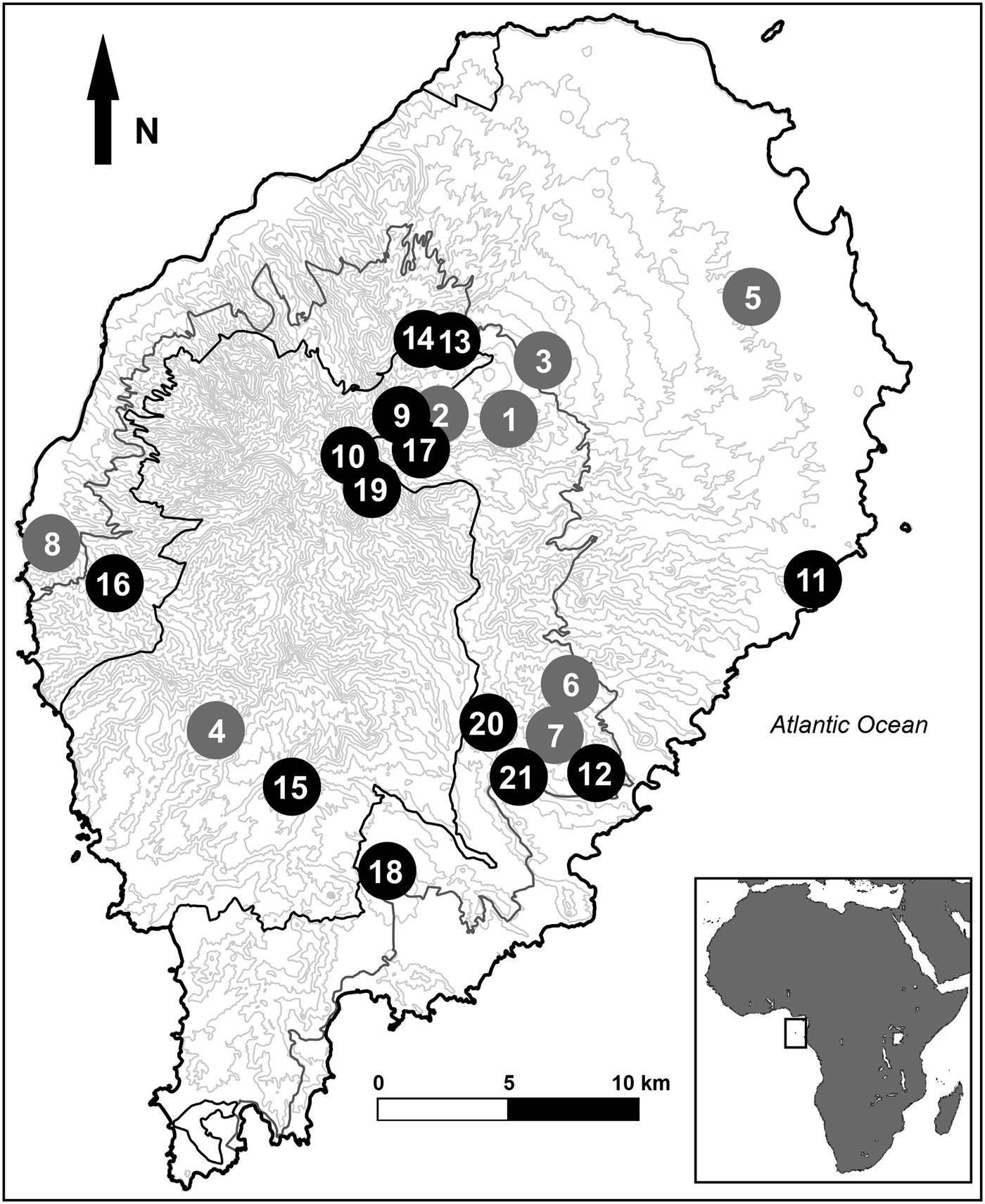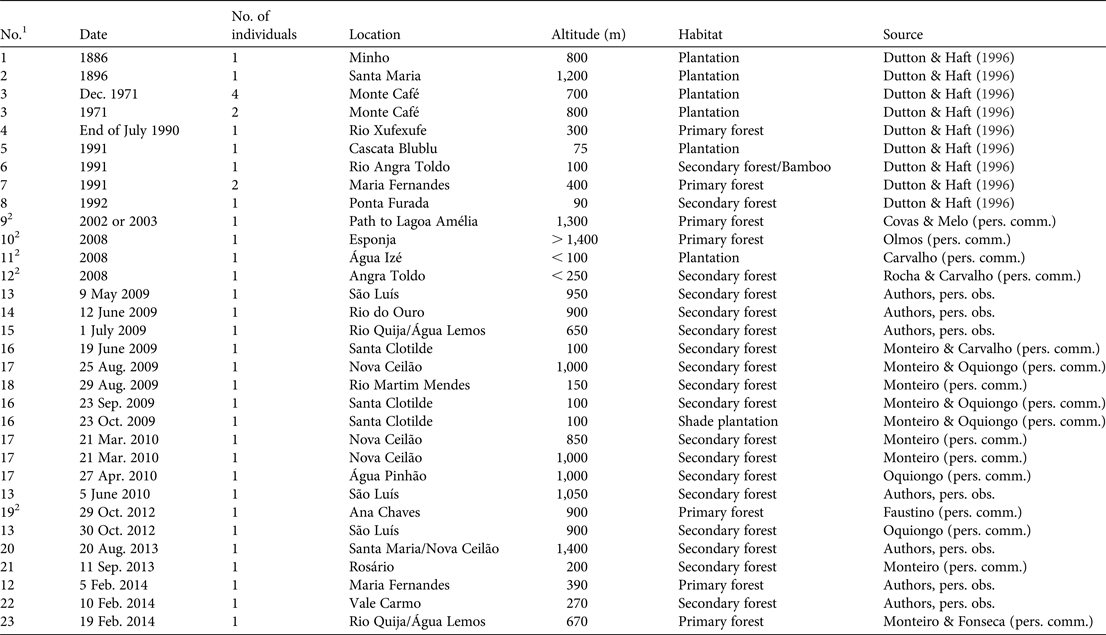The shrew Crocidura thomensis is endemic to São Tomé, an 857 km2 oceanic island lying just north of the equator and 255 km west of mainland Africa. The island belongs to the Democratic Republic of São Tomé and Príncipe and has a diverse range of unique species across many taxonomic groups (Jones, Reference Jones1994). The shrew was first described by Bocage (Reference Atkinson, Dutton, Peet and Sequeira1887) and is the island's only native non-volant mammal. Its endemicity is widely accepted and supported by molecular data (Maloney et al., unpubl. data). It was recorded only nine times in over a century and these records were used by Dutton & Haft (Reference Dutton and Haft1996) to assess its distribution, ecology and conservation status. Here, we reassess that knowledge based on new observations recorded sporadically by researchers in recent years.
We collated 23 new observations of the shrew, from 15 new locations (Fig. 1, Table 1). The high number of recent observations suggests the species may not be so rare, and the scant historical records are probably attributable to minimal search effort (Atkinson et al., Reference Albuquerque, Cesarini and Tagliabue1994). The shrew is widely distributed across São Tomé, occurring from near sea level to high altitudes. Its extent of occurrence may reach 500 km2, if it includes most of the island's forests (Salgueiro & Carvalho, Reference Salgueiro and Carvalho2001). These data contradict Hutterer (2008), who suggested it was an uncommon to very rare species associated with montane moist forest.

Fig. 1 Locations where the endemic shrew Crocidura thomensis was recorded on the island of São Tomé. Grey dots mark the location of records compiled by Dutton & Haft (Reference Dutton1996; point 1 has been reassigned to its correct location); black circles mark new locations. Numbers correspond to Table 1. The pale grey lines in the background mark 100 m altitudinal isohyets. The São Tomé Obô Natural Park and its buffer zone are delimited by black and dark grey lines, respectively. The rectangle on the inset shows the location of the island off the west coast of Africa. Shapefiles were adapted from the Natural Park Management Plan (Albuquerque et al., Reference Albuquerque, Cesarini and Tagliabue2008).
Table 1 Known records of the shrew Crocidura thomensis, endemic to São Tomé (Fig. 1), with date recorded, number of individuals, location, altitude, habitat, and data source.

1 Numbers correspond to those in Fig. 1
2 Approximate locations
The lack of systematic surveys across the island makes it difficult to assess abundance or identify areas where the shrew may be absent. Nevertheless, the species seems to be associated with areas of high rainfall and rugged terrain (Silva, Reference Silva1958; Fig. 1). Given that the north-east of São Tomé is one of the most visited areas of the island, the fact that the shrew was recorded only once in this region (in a plantation near riparian gallery forest) suggests the species is less abundant there. The north-east holds the only dry biomes of São Tomé (Silva, Reference Silva1958), and the most human-dominated landscapes (Jones et al., Reference Jones, Burlison and Tye1991; INE, Reference Hutterer2013); the combined effect of these conditions may be limiting the occurrence of the shrew. The large number of records for the mountainous central area of the island is likely to have resulted from this being the most visited region, with a significant proportion of well-preserved forests.
The São Tomé shrew occupies a variety of habitats, from old-growth mist forest to lowland plantations. However, most observations, and especially those in recent years, have been in rugged forested areas (Table 1). The distribution of new observations coincides with that of previous records but there is an apparent shift in habitat: five of eight of the earlier observations were in plantations, compared to two of the 23 new observations (Table 1). This shift may be attributable to an unbalanced survey effort but plantations have been visited frequently since 2008 (e.g. de Lima et al., Reference Bocage2014); the scarcity of records in plantations is therefore better explained by an effective decrease of the species in this habitat. This decline is corroborated by verbal accounts from local inhabitants.
Introduced species, the use of pesticides, and agricultural intensification have been identified as threats to the survival of the shrew (Atkinson et al., Reference Albuquerque, Cesarini and Tagliabue1994; Dutton & Haft, Reference Dutton1996), and provide reasonable causality for its decline in the agricultural matrix. Many species have been introduced to São Tomé, some of which have been identified as potential predators or competitors of the shrew (Atkinson et al., Reference Albuquerque, Cesarini and Tagliabue1994; Dutton, 1994) or are contributing to overall habitat degradation (de Lima et al., Reference Bocage2014). Few people can afford to use pesticides on a regular basis but the potential impact of pesticide use on the shrew should not be ignored as it has been implicated in the decline of the endemic insectivorous São Tomé paradise flycatcher Terpsiphone atrochalybeia (Jones et al., Reference Jones, Burlison and Tye1991). There is little information available on forestry or agricultural practices in São Tomé but there are signs of deforestation, forest degradation and agricultural intensification (Salgueiro & Carvalho, Reference Salgueiro and Carvalho2001; GeoVille, Reference Dutton and Haft2013). The human population increased from 100,000 in the mid 1980s to almost 170,000 in 2012 and is projected to continue growing rapidly (INE, Reference Hutterer2013). In this context the demand for agricultural and forest resources is likely to increase and contribute to continuing degradation of the shrew's habitat.
Little is known about the diet of this shrew. Dutton & Haft (Reference Dutton1996) reported a captive specimen consuming freshwater shrimp, crab, moths, earthworms and grasshoppers. We observed it feeding on earthworms, cockroaches, moths, crickets and a centipede (Scolopendra sp.). Field observations associate the shrew with wet environments, where many of the above-mentioned and other potential food items are particularly abundant (e.g. spider crickets, Phalangopsinae). We hypothesize that the shrew's association with wet environments is linked to the abundance of food in these locations, which is needed to satisfy the species' high metabolic rate.
Hutterer (2008) categorized the species as Endangered on the IUCN Red List, based on an extent of occurrence < 1,000 km2, with all individuals in a single location and a sustained decline of habitat extent and quality (B1ab(iii); IUCN, 2001). Despite the new information provided here, these criteria still apply and the species should therefore retain its Endangered status.
The São Tomé Obô Natural Park was created in 2006 and protects the island's main forest block (DGA, Reference de Lima, Viegas, Solé, Soares, Dallimer, Atkinson and Barlow2006; Fig. 1). Its establishment was a major step towards recognizing the conservation value of São Tomé's forests and demonstrated the willingness of the Santomean government to protect them. Effective protection of the Park is the most important measure to ensure the survival of the shrew, but enforcement remains almost non-existent. It is necessary to gain better knowledge of the shrew's distribution, abundance, ecology and threats (Nicoll & Rathbun, Reference Nicoll and Rathbun1990), especially concerning the impact of introduced species (Atkinson et al., Reference Albuquerque, Cesarini and Tagliabue1994). Testing the food-limitation hypothesis and the association with wet environments is also important, to evaluate the species' vulnerability to climate change. In recent years there have been several long and intense dry seasons, which could pose an additional threat to the long-term subsistence of this unique mammal.
Acknowledgements
RFL was funded by Fundação para a Ciência e a Tecnologia (SFRH/BD/36812/2007 & SFRH/BPD/91494/2012) and by a Rufford Small Grant for Conservation (50.04.09). The observations from 2013 and 2014 were collected in partnership with BirdLife International, Sociedade Portuguesa para o Estudo das Aves and the Royal Society for the Protection of Birds, with the support of the Disney Worldwide Conservation Fund. We thank Rita Covas, Martim Melo, Mariana Carvalho, Ricardo Rocha, Fábio Olmos, Gabriel Oquiongo, Aristides Monteiro, Augusto Faustino and Ricardo da Fonseca for sharing the details of their observations, and the Director General for the Environment of São Tomé and Príncipe, Arlindo Carvalho, for giving us permission to conduct our work. Finally, we would like to thank Martin Dallimer, Jorge Palmeirim and two anonymous reviewers for helpful comments.
Biographical sketches
Ricardo Faustino de Lima is researching the effects of human activities on the biodiversity of the endemic-rich islands of São Tomé and Príncipe. Eden Maloney has studied the phylogenetics of the shrews of São Tomé and Príncipe. W. Brian Simison's research focuses on the global phylogeography of limpets. Robert Drewes has extensive research experience in Africa and has been leading multidisciplinary expeditions to São Tomé and Príncipe since 2001.






